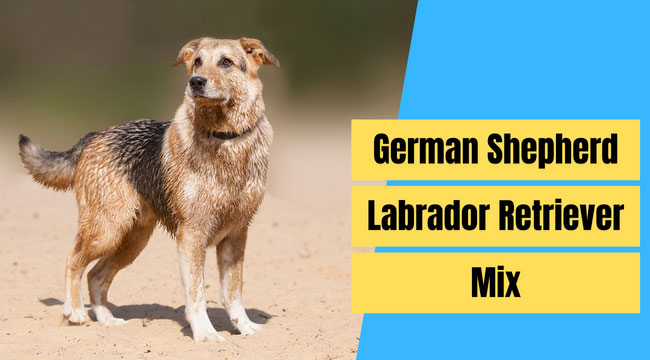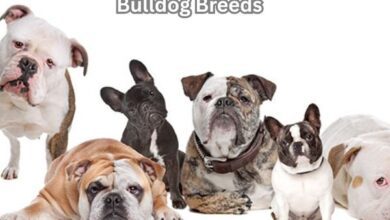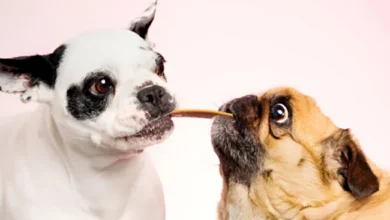German Shepherd Lab Mix – Dog Breed Guide

Even if you’re not a dog lover, you must’ve heard of German Shepherds and Labrador Retrievers. These are two of the most popular dogs in America, if not the world. The American Kennel Club ranks Labrador Retrievers and German Shepherds as #1 and #2 on their popularity list.
You are here because you wanna know what is German Shepherd and Labrador mix are, its characteristics, and whether or not you should get one for yourself!
Well, worry no more!
Here in this comprehensive guide, we are going to talk about everything that you ever wanted to know about German Shepherd Lab Mix. Keep on reading.
Read More: Border Collie Lab Mix
What is a German Shepherd Lab Mix?
Simply put, a German Shepherd Labrador Mix is a “designer” breed dog that combines the best of both the Labradors and Shepherds breeds. This multi-talented breed is recognized by the Dog Registry of America, Inc. (DRA) and the International Designer Canine Registry (IDCR).
The Origins of German Shepherd Lab Mix
Lab Shepherd Mix comes from mating two purebred dogs – a German Shepherd and a Labrador Retriever. Both purebred dogs have a rich ancestry that can be traced a long way back in history. German Shepherd Lab Mix isn’t as popular as other cross-breeds like Goldendoodle (Golden Retriever + Poodle) or Puggle (Pug + Beagle), but they are loved and adored by many.
German Shepherd Origin
German Shepherd breed was a result of the passionate German vet, Max von Stephanitz. He became fascinated by the resourcefulness, stamina, and intelligence of Germany’s sheepdogs. He bought a male sheepdog in 1899 which embodied all the best quality and named it Horand Von Grafrath. The descendants of Horand are the German Shepherds you know now.
During the First World War, German Shepherds worked as messenger, rescue, sentry and guard dogs. The breed became even more famous when Rin Tin Tin— a German Shepherd rescued from WWI battlefield—became a Hollywood star.
Read More: German Shepherd Golden Retriever Mix
Labrador Retriever Origin
Labrador Retrievers are descendants of Canada’s now extinct St. John’s water dogs. St. John’s water dogs were from Newfoundland and Labrador; they were a mix of English, Irish and Portuguese Working Dogs.
In the 1700s, the Labs were bred to help fishermen with the net, lines and retrieving fish. Not only they are hard workers, but they are also friendly, sweet, and smart. An Englishmen saw the Lab’s fascinating traits and took one back to his home country where the dog was given the name “Retriever”.
It’s sad that AKC still hasn’t recognized them officially, even though they are really popular and earned a few adorable nicknames like German Sheprador, Labrashepherd, etc.
Physical Characteristics of a German Shepherd Lab Mix

German Shepherd Labrador Mix are large in size, weighing between 45-95 lbs (20-43 Kg) for males and 35-45 lbs (16-20 Kg) for females. They tend to have a strong body, like a German Shepherd, and a face like a Labrador Retriever. A typical Sheprador can get up to 20-26 inches in height (50-65 cm).
Their most important difference can be noticed in their tails, which can be either thick like the Labrador or fluffy like the Shepherd. With a long muzzle and dark brown eyes, a Sheprador is beautiful to look at. Their coat is double layered, dense, short to medium in length with water-repellent properties. They usually inherit coat colorings, patterns, and markings from their parents.
I, personally, like black Lab German Shepherd Mix. They are so cool!
Personality and Temperament of a German Shepherd Lab
As a mix of two breeds, the Shepherd Lab Mix can inherit any combination of their parent’s traits. Commonly, both Shepherds and Retrievers are intelligent, fast learners and eager to please their owners. They are also very energetic—a trait very common in Shepradors.
Many are wary that the traits of German Shepherds may interfere with the fun-loving attitude of the Labrador. German Shepherds are very popular as law-enforcement canine units and are generally seen as attack dogs.
However, Shepradors are generally cautious and even-tempered. They are fun-loving towards family and weary towards strangers. This trait makes them excellent watchdog material. Their cautious behavior comes from a fierce loyalty to protect their family.
Shepradors are very patient with children and other pets and can keep up with any level of mischief; however, their guardian nature will kick into gear the moment they sense danger.
Health Concerns of a German Shepherd Lab
A Sheprador’s lifespan varies from 10-14 human years. Compared to other large breed dogs, they are on the high end, if not the highest. They also outlive their parents in terms of life expectancy.
However, a good healthy life depends on a lot of factors. The Lab German Shepherd Mix can inherit any of the health conditions their parents are prone to.
Labrador Health Problems
Labradors’ biggest health concern is their hip and elbow dysplasia. The joint pains lead to arthritis, which makes their movement stiff and painful.
Besides arthritis, Labs also face progressive retinal atrophy—their retinas fail and can leave them blind.
They can also be voracious eaters and as such, are prone to obesity, despite their high energy levels and exercise needs.
German Shepherd Health
German Shepherds come from a small gene pool, and due to breeders pushing an exaggerated shape for the dog, they face a plethora of problems in their life.
Some of the few notable ones are:
- Elbow and Hip Dysplasia
- Gastric Dilatation-Volvulus
- Chronic Degenerative Radiculomyelopathy
- Panosteitis
- Gastrointestinal Diseases
- Anal Infections
- Eye Diseases
- Allergies
- Epilepsy
- Underactive Thyroid
There has been evidence that German Shepherd Labrador Mix and Lab German Shepherd Mix, like most crossbreed dogs, live longer than pedigree breeds. This is because many problems related to joints and eyes can be eliminated before breeding. Conditions like obesity can be controlled with the use of regular nutritious food.
Trainability, Exercise Needs and Grooming of a German Shepherd Lab Mix

#1. Trainability
German Shepherd Lab Mix gets its training genes from both sides of the family tree. Both Shepherds and Labradors are very obedient. That trait is passed along to Shepradors, along with intelligence.
A positive attitude is highly recommended while training them—they won’t respond to dominating methods. Small food rewards as an encouragement will forge a never-ending bond within the family.
A Shepherd Lab Mix can also socialize and supervise children if trained properly.
#2. Exercise Needs
As both parents come from a working-dog class, Shepradors need a lot of exercises… and we mean a lot! They are best suited for people or families with an active lifestyle.
Apartment owners are not recommended to get a Lab German Shepherd Mix because they need plenty of space to run around. Besides the usual physical activities, they also need mental stimulation for proper growth.
They do extremely well with company, so if you are planning to get a German Shepherd Lab Mix puppy, get ready for a lot of running, jogging, hiking and playing. Make sure you get some dog puzzles and toys appropriate for their age. They love to chew and if you leave your shoes unattended, they will chew them to bits.
Shepradors do not do well if left alone for extended periods of time. If you don’t give them company, they will find something else to do, like messing up your house.
#3. Grooming
Get prepared to become best friends with a vacuum cleaner as your German Shepherd Labrador will have crazy shedding sessions. Their double coat will need weekly grooming, at least. If your German Shepherd Lab Mix Puppy is “blessed” with a longer and shaggier coat, then they should be groomed several times weekly rather then only once-a-week.
It’s natural for them to have extensive grooming because both parent lines are abundant shedders. To keep a Sheprador’s hair shiny and silky, brush her for at least 10-15 minutes.
Besides upgrading your brushwork skills, you also need to clear her ears (once a week), brush her teeth (three times a week) and clean her eyes. Her nails need the most care as they are translucent, strong and have both nerves and blood vessels. Don’t try to trim them yourself unless you know what you are doing. She only needs a bath once a month, unless she is really dirty.
Buying German Shepherd Lab Mix Puppy
Getting a puppy is a commitment, and getting a German Shepherd Labrador Mix Puppy requires even more. You need to find a good breeder who genuinely loves German Shepherds and Labradors.
The most important part of getting a German Shepherd Lab Mix puppy is meeting both parents. If you can’t meet both, check out how temperamental the German Shepherd is, because their personalities tend to very much more than Labradors.
Make sure both parents have good hip and elbow scores and recent eye tests done. Check if they have a certification from the Orthopedic Foundation for Animals (OFA), hereditary medical problems, etc.
Good breeders always invest in their puppies, so going for the cheapest one is not a good option. You need to do a bit of homework before making the decision to get a German Shepherd Lab Puppy.
Conclusion
The decision of buying or adopting a pet is a huge decision because it means adding a new member to the family. And every family has values and a specific lifestyle they follow, which is why it’s important that we choose a pet that fits well with the family.
A Sheprador is a very active family dog breed that is totally devoted to its owners. So if you are looking for a loyal companion with whom you can go for your morning run, a Sheprador is definitely a great option for you.
Read More: Beagle Pitbull Mix – Is This Cross Right for You?



